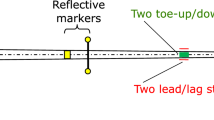Abstract
A common belief in the golf community is that a lighter shaft allows the golfer to swing the club faster. From a mechanical point of view, reducing the mass of the shaft would result in a faster swing. However, a golfer is not a purely mechanical system, and so it is simplistic to assume that identical loads will be applied when swinging different clubs. Therefore, the purpose of this study was to test the hypothesis that golfers behave similar to a mechanical model when swinging clubs of varying mass. A torque driven model estimated the effects caused by the addition of 22 g to the shaft. Twelve golfers hit balls with a standard driver as well as a driver fitted with the same 22 g increase in mass. Club kinematics were collected with a high-speed motion capture system. The model predicted a 1.7 % lower club head speed for the club with additional mass. One subject showed a similar reduction (1.4 %), but one subject showed an increase in club head speed by 3.0 %. Ten subjects did not show any significant differences. These results suggest that golfers do not respond to changes in club mass in a mechanically predictable way.




Similar content being viewed by others
Notes
Within manufacturing tolerances. A weight deviation of about 2.1 g for the plain shafts is one example for a slight deviation.
References
Betzler N, Monk S, Wallace E, Otto SR, Shan G (2008) From the double pendulum model to full-body simulation: evolution of golf swing modeling. Sports Technol 1(4–5):175–188. doi:10.1002/jst.60
Daish CB (1972) The physics of ball games, 1st edn. The English University Press, London
Harper TE, Roberts JR, Jones R (2005) Driver swingweighting: a worthwhile process? Proc Inst Mech Eng B J Eng Manuf 219(5):385–393. doi:10.1243/095440505X32247
Harwell MR, Rubinstein EN, Hayes WS, Olds CC (1992) Summarizing monte carlo results in methodological research: the one- and two-factor fixed effects ANOVA cases. J Educ Stat 17(4):315–339. doi:10.3102/10769986017004315
Jorgensen T (1994) The physics of golf. Contemporary physics, vol 35. American Institute of Physics, Woodbury
Kenny IC, Wallace ES, Otto SR (2008) Influence of shaft length on golf driving performance. Sports biomech Int Soc Biomech Sports 7(3):322–332. doi:10.1080/14763140802233249
Lampsa M (1975) Maximizing Distance of the golf drive: an optimal control study. J Dyn Syst Meas Contr 97:362
Lix LM, Keselman JC, Keselman HJ (1996) Consequences of assumption violations revisited: a quantitative review of alternatives to the one-way analysis of variance F test. Rev Educ Res 66(4):579–619. doi:10.3102/00346543066004579
MacKenzie SJ, Sprigings EJ (2009) A three-dimensional forward dynamics model of the golf swing. Sports Eng 11(4):165–175. doi:10.1007/s12283-009-0020-9
McDonald JH (2009) Handbook of biological statistics, 2nd edn. Sparky House Publishing, p 319
Nachtigall C, Wirtz M (2006) Wahrscheinlichkeitsrechnung und Inferenzstatistik, 4th edn. Juventa, Weinheim
Pelz D (1990) A simple, scientific, shaft test: steel versus graphite. In: Cochran AJ (ed) Science and golf. E & F N Spon, St. Andrews, pp 264–269
Penner AR (2003) The physics of golf. Rep Prog Phys 66(2):131–171. doi:10.1088/0034-4885/66/2/202
Pickering WM, Vickers GT (1999) On the double pendulum model of the golf swing. Sports Eng 2(3):161–172. doi:10.1046/j.1460-2687.1999.00028.x
Reyes MG, Mittendorf A (1998) A mathematicsl swing model for a long-driving champion. In: Farrally MR, Cochran AJ (eds) Science and golf III. Human Kinetics, St. Andrews, pp 13–19
Van Gheluwe B, Deporte E, Ballegeer K (1990) The influence of the use of graphite shafts on golf performance and swing kinematics. In: Cochran AJ (ed) Science and golf. E & F N Spon, St. Andrews, pp 258–263
White R (2006) On the efficiency of the golf swing. Am J Phys 74(12):1088. doi:10.1119/1.2346688
Worobets JT, Stefanyshyn DJ (2007) Shaft stiffness significantly influences golf clubhead speed at impact. Program and Abstracts of the XXI Congress, International Society of Biomechanics. J Biomech 40(Supplement 2):S279. doi:10.1016/S0021-9290(07)70275-0
Acknowledgments
The authors would like to thank Geoff Smith for the assistance with the experimental setup, and all subjects for their participation in the study.
Author information
Authors and Affiliations
Corresponding author
Rights and permissions
About this article
Cite this article
Haeufle, D.F.B., Worobets, J., Wright, I. et al. Golfers do not respond to changes in shaft mass properties in a mechanically predictable way. Sports Eng 15, 215–220 (2012). https://doi.org/10.1007/s12283-012-0104-9
Published:
Issue Date:
DOI: https://doi.org/10.1007/s12283-012-0104-9




